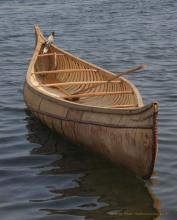Contact
The fur trade caused Native people to become partially dependent on European trade goods, changing their traditional balance between needs and resources. The fur traders introduced alcohol, causing social and health problems among the Indians.
Native North Americans had never been exposed to some diseases common in Europe, including smallpox, hepatitis, chicken pox, pneumonia, and measles, and so had never developed any immunityImmunity
Resistance to disease, developed naturally or through exposure.. Major epidemicsEpidemic
Affecting or tending to affect a disproportionately large number of individuals within a population, community, or region at the same time. began around 1616, and from a population of about 20,000 in the early 1600s, only about 5,500 Native people survived by 1650. Neither the Indians nor the Europeans understood the cause of disease, but thanks to the Europeans' greater immunity, they contracted fewer and milder illnesses. Some Natives thus came to believe in the superiority of the Europeans’ religion and converted to Christianity, causing further erosion of traditional Indian life.
The spread of European settlement in the eighteenth century, along with the mast trade, destroyed much of Maine’s forestland. Eventually, timber products began to be exported to Europe. Sawmills were built, (the first as early as 1630), and dams were needed to produce waterpower to run the mills. Over time, sawdust silted up the rivers and smothered shellfish. Dams prevented the spawningSpawn
The eggs of fish, or, as a verb, the laying of eggs by fish. migration of fish up the rivers, and interfered with an important source of food for Native Americans.
Clearing forests for lumber and farms changed the soil and created more temperature extremes in Maine. Settlers’ farm animals destroyed the shoots of new trees and trampled the land. The compacted soil was less fertile and less absorbent. The environmental pressure exerted by the settlers was not only a result of numbers, but also of their subsistence methods.
By 1760, only about 900 Native Americans were left in Maine.
By the 1800s even the beaver population had begun to suffer from over-hunting. Indians were forced to make a living in other ways, including basket making, fishing, guiding, seal hunting (for oil and skins); and making snowshoes, paddles, ax handles, and canoes. Later in the 19th century, many Indians worked in the logging industry. By the mid-1800s, many had given up traditional wigwamsWigwam
A hut of the Native Americans of the Great Lakes region and eastward, typically having an arched framework of poles overlaid with bark, rush mats, or hides. for wooden houses, some turned to farming, and many sold their traditional crafts to visitors.
By the late 1800s the Penobscot valley had been clear cut to support the lumber industry. The large birch trees needed for canoes were gone, and traditional crafts began to die out. Along the Penobscot River, mass-produced Indian crafts were sold to tourists.

